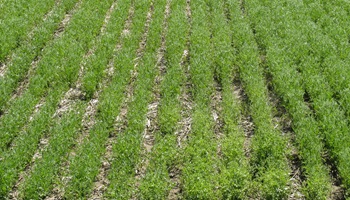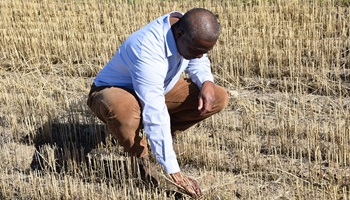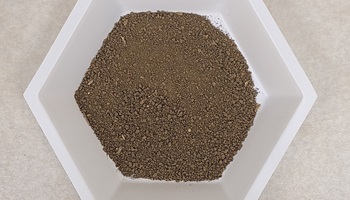For further information
Media Relations
Agriculture and Agri-Food Canada
1-866-345-7972
aafc.mediarelations-relationsmedias.aac@agr.gc.ca
Nitrogen is essential for crop growth and farmers in the Prairies apply it in various forms to their fields. However, this input comes at a financial cost and excess can harm the environment. Therefore, understanding how to manage it is important to everyone.
Researcher Dr. Mervin St. Luce of the Swift Current Research and Development Centre is advancing our knowledge of nitrogen use in a number of ways.
Nitrogen use in different plants and different places
Dr. St. Luce and colleagues have been studying ways to both improve nitrogen use efficiency in cropping systems and optimize nitrogen fertilizer recommendations.
Teaming up with Dr. Bao-Luo Ma of the Ottawa Research and Development Centre and others, Dr. St. Luce co-led a project to provide canola producers with a complete information guide of site-specific nitrogen management practices for various agri-ecozones. In this project, the team investigated the impact of nitrogen fertilizer rates and timing on modern canola hybrids, as well as the effect of nitrogen fertilizer rates and frequency in rotation on both canola yield and nitrogen use efficiency. At the same time, they tested soil- and plant-based diagnostic tools for accurate and rapid assessment of nitrogen sufficiency in canola, and evaluated estimations of soil nitrogen supply using soil spectroscopy as possible ways to optimize nitrogen fertilizer recommendations.
Studies are also looking at better understanding how pulse crops, such as field peas, chickpeas, lentils and faba beans, affect nitrogen cycling. Unlike most plants, which take nitrogen from the soil and from nitrogen fertilizer when applied, these crops can “fix” (utilize) nitrogen from the atmosphere for their own use, and increase nitrogen presence in the soil.
“Nitrogen is essential for plants and to achieve optimum yields, but its efficient use and management is critical for farm profitability, long-term soil health and environmental sustainability.”
- Dr. Mervin St. Luce, Research Scientist
The effect of diverse farming practices
The influence of agricultural practices and other human activities cannot be underestimated when it comes to nitrogen.
Dr. St. Luce notes that nitrogen cycling can be impacted by a variety of factors such as:
- the way nitrogen fertilizer is applied - including variables such as the source, rate, placement and time at which it is applied (known as “4R practices”)
- the type of and method of handling crop residues (such as straw and chaff left at the end of the growing season)
- soil and environmental conditions such as soil texture, precipitation and temperature
- organic vs. conventional cropping methods
- the farming practices chosen, such as tillage and crop rotation.
One way to study how nitrogen moves through the crop and soil is by using nitrogen-15 isotopes as a tracer. In partnership with other AAFC scientists, including Dr. Benjamin Ellert of the Lethbridge Research and Development Centre, Dr. St. Luce is using this technique to simultaneously trace and accurately quantify nitrogen derived from above-ground and below-ground crop residues left in the field, as well as from nitrogen fertilizer applied to crops. This will help to quantify the amount of nitrogen a farmer should expect in the soil after growing a pulse crop and how long it will remain present. Further, the study also looks at the effects of leaving – or not leaving - pulse crop residues in the field. Additionally, results from this study will provide a better understanding of the fate of nitrogen fertilizer applied to crops with respect to the cropping system and nitrogen application rate.
Conservation agriculture’s impact on soil organic carbon and total nitrogen
Another interesting study Dr. St. Luce led compared the results of conservation agriculture on commercial fields in the semi-arid Prairies, to long-term research plots.
Conservation agriculture practices, such as no-till, continuous cropping, the use of cover crops and diversity in crop rotations enhances soil organic matter and long-term sustainability; however, most of the related studies are done on research plots, which are much smaller than commercial fields.
To gain a better understanding of the impact of conservation agriculture in commercial fields, researchers studied fields in southwest Saskatchewan, some of which had been under conservation practices for up to 21 years. The study showed that direct-seeding and continuous cropping increased soil organic carbon and soil total nitrogen. The research team notes that actual on-farm changes will depend on site-specific soil and environmental factors, as well as the specific conservation agriculture practices employed.
Further research related to nitrogen and soil conservation practices is ongoing.
Photo gallery

Pulse plants, such as lentils, have nitrogen-fixing bacteria that live in their root nodules

Dr. Mervin St. Luce looks at groundcover after a fall harvest in one of the long-term cropping system studies in Swift Current

The soil in the semi-arid prairie, which covers a large area of the south-western Prairies, is typically this light brown colour